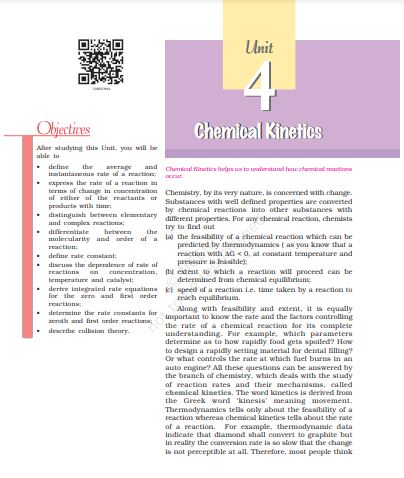‘NCERT Solutions for Class 12 Chemistry Chapter 4‘ PDF Quick download link is given at the bottom of this article. You can see the PDF demo, size of the PDF, page numbers, and direct download Free PDF of ‘Ncert Class 12 Chemistry Chapter 4 Exercise Solution’ using the download button.
NCERT Class 12 Chemistry Textbook Chapter 4 With Answer PDF Free Download

Chapter 4: Chemical Kinetics
Chemistry, by its very nature, is concerned with change. Substances with well-defined properties are converted by chemical reactions into other substances with different properties.
For any chemical reaction, chemists try to find out
(a) the feasibility of a chemical reaction which can be predicted by thermodynamics ( as you know that a reaction with ∆G < 0, at constant temperature and pressure, is feasible);
(b) the extent to which a reaction will proceed can be determined by chemical equilibrium;
(c) speed of a reaction i.e. time taken by a reaction to reach equilibrium.
Along with feasibility and extent, it is equally important to know the rate and the factors controlling the rate of a chemical reaction for its complete understanding.
For example, which parameters determine how rapidly food gets spoiled? How to design a rapidly setting material for dental filling?
Or what controls the rate at which fuel burns in an auto engine? All these questions can be answered by the branch of chemistry, which deals with the study of reaction rates and their mechanisms, called chemical kinetics.
The word kinetics is derived from the Greek word ‘kinesis’ meaning movement. Thermodynamics tells only about the feasibility of a reaction whereas chemical kinetics tells about the rate of a reaction.
For example, thermodynamic data indicate that diamond shall convert to graphite but in reality, the conversion rate is so slow that the change is not perceptible at all.
Therefore, most people think that diamond is forever. Kinetic studies not only help us to determine
the speed or rate of a chemical reaction but also describe the conditions by which the reaction rates can be altered.
The factors such as concentration, temperature, pressure, and catalyst affect the rate of a reaction.
At the macroscopic level, we are interested in amounts reacted or formed and the rates of their consumption or formation.
At the molecular level, the reaction mechanisms involving orientation and energy of molecules undergoing collisions, are discussed.
In this Unit, we shall be dealing with the average and instantaneous rate of reaction and the factors affecting these.
Some elementary ideas about the collision theory of reaction rates are also given.
However, in order to understand all these, let us first learn about the reaction rate.
Some reactions such as ionic reactions occur very fast, for example, precipitation of silver chloride occurs instantaneously by mixing aqueous solutions of silver nitrate and sodium chloride.
On the other hand, some reactions are very slow, for example, rusting of iron in the presence of air and moisture.
Also, there are reactions like an inversion of cane sugar and hydrolysis of starch, which proceed at a moderate speed. Can you think of more examples from each category?
Molecularity of a Reaction
Another property of a reaction called molecularity helps in understanding its mechanism.
The number of reacting species (atoms, ions, or molecules) taking part in an elementary reaction, which must collide simultaneously in order to bring about a chemical reaction is called the molecularity of a reaction.
The reaction can be unimolecular when one reacting species is involved, for example, the decomposition of ammonium nitrate
Zero Order Reactions
Zero-order reaction means that the rate of the reaction is proportional to the zero power of the concentration of reactants. Consider the reaction.
| Author | NCERT |
| Language | English |
| No. of Pages | 28 |
| PDF Size | 2.9 MB |
| Category | Chemistry |
| Source/Credits | ncert.nic.in |
NCERT Solutions Class 12 Chemistry Chapter 4 Chemical Kinetics
Q 1. From the rate expression for the following reactions, determine their order of reaction and the dimensions of the rate constants.
(a) [latex]3\; NO(g) \rightarrow N_{2}O (g) \; Rate = k\left [ NO \right ]^{2}[/latex]
(b) [latex]H_{2} O_{2} (aq) + 3I^{-}(aq) + 2H^{+} \rightarrow 2H_{2}O (I) + I^{-} \; Rate = k \left [ H^{2}O^{2} \right ]\left [ I^{-} \right ][/latex]
(c) [latex]CH_{3}CHO (g) \rightarrow CH_{4} (g) + CO (g) \; Rate = k\left [ CH_{3} CHO \right ]^{\frac{3}{2}}[/latex]
(d) [latex]C_{2}H_{5}Cl (g) \rightarrow C_{2}H_{4} (g) + HCl (g) \; Rate = k\left [ C_{2} H_{5}Cl \right ][/latex]
Ans:
(a) Given rate = [latex]k\left [ NO \right ]^{2}[/latex]
Therefore, order of the reaction = 2
Dimensions of [latex]k = \frac{Rate}{\left [ NO \right ]^{2}}[/latex] [latex]\\ = \frac{mol \; L^{-1} s^{-1}}{\left ( mol \; L^{-1} \right )^{2}} \\ \\ = \frac{mol \; L^{-1} s^{-1}}{mol^{2}\; L^{-2}} \\ \\ = L \; mol^{-1} s^{-1}[/latex]
(b) Given rate = [latex]k[ H_{2}O_{2} ][ I ^{-}][/latex]
Therefore, order of the reaction = 2
Dimensions of [latex]k = \frac{Rate}{\left [ H_{2}O_{2} \right ]\left [ I^{-} \right ]}[/latex] [latex]\\ = \frac{mol \; L^{-1} S^{-1}}{\left ( mol \; L^{-1} \right ) \left ( mol \; L^{-1} \right )} \\ \\ = L \; mol^{-1} s^{-1}[/latex]
(c) Given rate = [latex]= k \left [ CH_{3} CHO \right ]^{\frac{3}{2}}[/latex]
Therefore, the order of reaction = [latex]\frac{3}{2}[/latex]
Dimensions of [latex]k = \frac{Rate}{\left [ CH_{3} CHO \right ]^{\frac{3}{2}}} \\ \\ = \frac{mol \; L^{-1}s^{-1}}{\left (mol \; L^{-1} \right )^{\frac{3}{2}}} \\ \\ = \frac {mol\; L^{-1} s^{-1}}{mol^{\frac{3}{2}}\; L^{\frac{3}{2}}} \\ \\ L^{\frac{1}{2}}\; mol^{ -\frac{1}{2}} \; s^{-1}[/latex]
(d) Given rate = [latex]k = \left [ C_{2}H_{5}Cl \right ][/latex]
Therefore, order of the reaction = 1
Dimension of [latex]k = \frac{Rate}{\left [ C_{2}H_{5}Cl \right ]} \\ \\ = \frac{mol\; L^{-1} s^{-1}}{mol \; L^{-1}} \\ \\ = s^{-1}[/latex]
Chemical Kinetics NCERT Solution PDF Free Download
